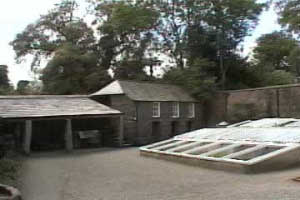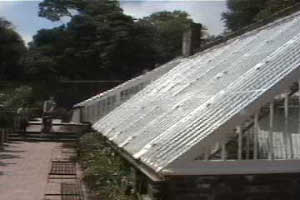Greenhouses of Heligan

The restored Victorian Banana House and entrance to the walled cutting/produce garden which is known as Heligan's 'Flower Garden'.

This walled area titled the'Mellon Yard' encompasses cold frames, pineapple pits, melon hothouse and another boiler house. The largest cold frame seen here, sported enormous strawberries in May while new potatoes are harvested there in winter. There is also a frame for salad greens and another for hardening off seedlings. The two-story structure is the Fruit and Root Store building which also boasts a two seater 'thunder box room'. On its left is a pole shed where compost and other ingredients where stored and mixed on the stone floor, producing Heligan's homemade potting soil. Next door is the potting shed and next to it is The Tool Store, displaying a heart-pounding array of antique garden tools.
Less than ten years ago, this scene was a mini-forest of 34 mature trees crawling with ivy and bramble. Roots had embedded themselves throughout the building's foundations and tree trunks were splitting their walls. Much was disassembled and rebuilt with original components, wherever possible. Additional materials of the Victorian era were sought out for replacement of destroyed slates, iron guttering, timber and ancient bricks, in keeping with Heligan's ongoing commitment to authentic restoration, where ever possible.

The Flower Garden's heater resides in its own little house and was described as "the Rolls Royce of boilers" in its Victorian day. This 'Weeks duplex upright tubular boiler' is still advertised today. Next to it is The Bothy where six Under Gardener's would reside, which adjoined the banana house seen above. All of this and the nearby Head Gardener's office must have been warmed by the one heat source.

Back inside the Flower Garden, the grape vinery is seen fronting the citrus house. These abut the garden wall and were once heated by a wood burning stove that flued directly into the hollow wall, before the more efficient steam radiator systems evolved. Ashes were collected from arched holes within the wall and I would imagine, were returned to the earth with gratitude. Nothing goes wasted in a self sufficient garden.

Heligan
Wild : A Year of Nature in the Lost Garden
by Colin Howlett